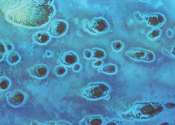Researchers study size, distribution and densities of intergalactic hydrogen clouds
Galaxies are often surrounded by a halo of hydrogen gas. Over time a galaxy can lose this halo, which streams off into the intergalactic medium. As a result, there can be clouds of hydrogen among the clusters of galaxies ...









